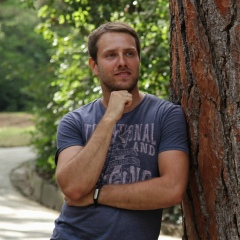Though there is no reason to suppose that abnormalities provide information about ancestral conditions, it is an undeniable truth - indeed a truism - that
aberrant forms, since they show what an organ can do, may sometimes throw light upon what it is.
(c) A. Arber (1937) The interpretation of the flower: a study of some aspects of morphological thought. Biol. Rev. 12: 157-184.
Блестящая, между прочим, мысль. Куча авторов (в том числе, советские ботаники-тератологи) утверждали, что нарушения развития - тераты - указывают на предковое состояние. Но на самом деле, речь о том, что они указывают на степени свободы той или иной структуры. Например, тычинка легко (у мутантов) превращается в лепесток, плодолистик, чашелистик или лист, потому что это всё гомологичные структуры. А вот корнем она никогда не станет.
Думаю, что то, насколько легко разные структуры могут превращаться друг в друга, - это ещё одно мерило гомологии.
На картинке - "махровые" цветки фуксии. Фото - steemit(dot)com.
aberrant forms, since they show what an organ can do, may sometimes throw light upon what it is.
(c) A. Arber (1937) The interpretation of the flower: a study of some aspects of morphological thought. Biol. Rev. 12: 157-184.
Блестящая, между прочим, мысль. Куча авторов (в том числе, советские ботаники-тератологи) утверждали, что нарушения развития - тераты - указывают на предковое состояние. Но на самом деле, речь о том, что они указывают на степени свободы той или иной структуры. Например, тычинка легко (у мутантов) превращается в лепесток, плодолистик, чашелистик или лист, потому что это всё гомологичные структуры. А вот корнем она никогда не станет.
Думаю, что то, насколько легко разные структуры могут превращаться друг в друга, - это ещё одно мерило гомологии.
На картинке - "махровые" цветки фуксии. Фото - steemit(dot)com.
Though there is no reason to suppose that abnormalities provide information about ancestral conditions, it is an undeniable truth - indeed a truism - that
aberrant forms, since they show what an organ can do, may sometimes throw light upon what it is.
(c) A. Arber (1937) The interpretation of the flower: a study of some aspects of morphological thought. Biol. Rev. 12: 157-184.
A brilliant, by the way, thought. A bunch of authors (including Soviet botanists-teratologists) claimed that developmental disorders - terats - indicate an ancestral state. But in fact, the point is that they indicate the degrees of freedom of a particular structure. For example, the stamen easily (in mutants) turns into a petal, carpel, sepals or leaf, because these are all homologous structures. But it will never become the root.
I think that how easily different structures can turn into each other is another measure of homology.
In the picture - "terry" fuchsia flowers. Photo - steemit (dot) com.
aberrant forms, since they show what an organ can do, may sometimes throw light upon what it is.
(c) A. Arber (1937) The interpretation of the flower: a study of some aspects of morphological thought. Biol. Rev. 12: 157-184.
A brilliant, by the way, thought. A bunch of authors (including Soviet botanists-teratologists) claimed that developmental disorders - terats - indicate an ancestral state. But in fact, the point is that they indicate the degrees of freedom of a particular structure. For example, the stamen easily (in mutants) turns into a petal, carpel, sepals or leaf, because these are all homologous structures. But it will never become the root.
I think that how easily different structures can turn into each other is another measure of homology.
In the picture - "terry" fuchsia flowers. Photo - steemit (dot) com.

У записи 32 лайков,
2 репостов,
897 просмотров.
2 репостов,
897 просмотров.







































![Евгения Акопова [949] Евгения Акопова [949]](https://sun9-38.vkuserphoto.ru/s/v1/ig1/cx0nHyMeLFYZfikdmLpDlbTmgfg5dmw2_qMOUQ6q4fEF80dWUoPvPahO1RMWspjL3ZqQGc5W.jpg?quality=96&crop=143,143,793,793&as=32x32,48x48,72x72,108x108,160x160,240x240,360x360,480x480,540x540,640x640,720x720&ava=1&cs=200x200)




![Юлия Март [Jull Mart] Юлия Март [Jull Mart]](https://sun9-3.vkuserphoto.ru/s/v1/ig2/IE8MuTB_UxbEVUQPpXcnDdPv9vk6UZ3h74udUTBY0c6SCRdD4DdRCMoyuH34sYm51wKqN9Ro8H_hoEbli1-35kQL.jpg?quality=95&crop=1,0,2025,2025&as=32x32,48x48,72x72,108x108,160x160,240x240,360x360,480x480,540x540,640x640,720x720,1080x1080,1280x1280,1440x1440&ava=1&cs=200x200)







